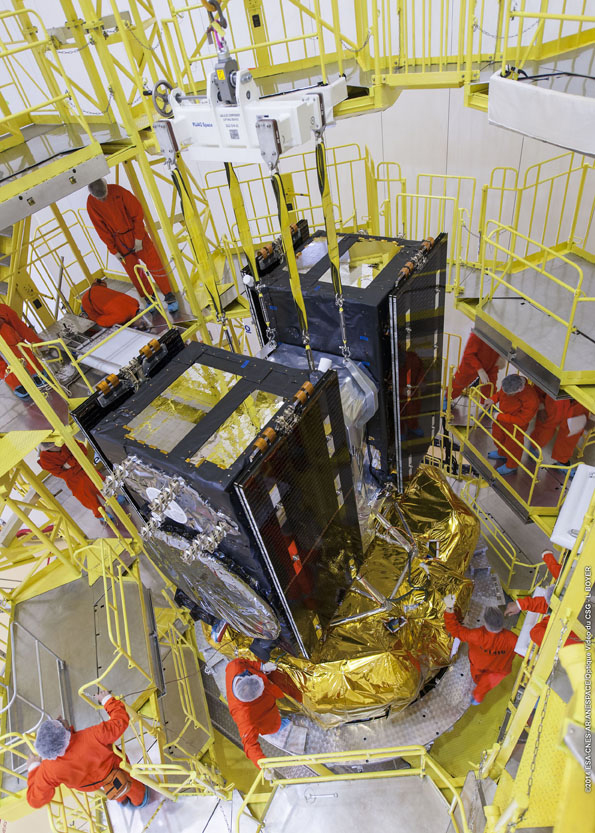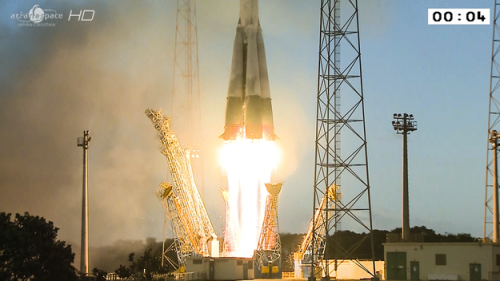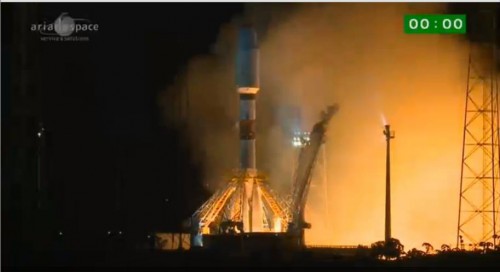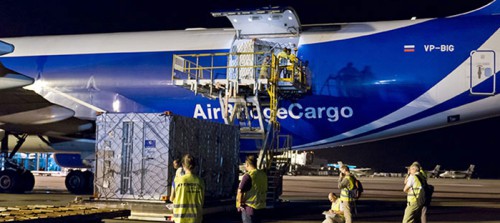
Less than three years since it became the first non-Russian organization to deliver a Soyuz booster into orbit from a location outside the borders of Russia or the former Soviet Union, Arianespace—the Paris, France-headquartered provider of commercial launch services from the Guiana Space Centre in Kourou, French Guiana—is set to deliver the first pair of Galileo Full Operational Capability (FOC-1) satellites on Thursday, 21 August. Operating from a “medium” Earth orbit, with a mean altitude of 14,600 miles (23,520 km), they will form part of an eventual 30-satellite global navigational constellation, developed under contract with the European Space Agency (ESA) and conducted under the auspices of the European Commission. Liftoff of the three-stage Soyuz vehicle, which is also equipped with a Fregat upper stage, is targeted to occur from Kourou’s Ensemble de Lancement Soyouz (ELS) complex at 9:31:14 a.m. GFT (8:31:14 a.m. EDT) and the two satellites should be delivered precisely into orbit a little under three hours and 48 minutes after launch.
Named “Doresa” and “Milena,” in honor of German and Estonian children who were among the winners of a 2011 European Commission painting competition, the Galileo FOC-1 satellites were delivered to Félix Eboué International Airport, near the French Guianese capital, Cayenne, in early May 2014, aboard a Boeing 747 cargo aircraft. Following unloading and inspection, they were both fueled in early August, ahead of integration with their specially designed, two-sided payload dispenser. On Friday, 15 August, the satellites and their dispenser were installed atop the Fregat, within the confines of Kourou’s S3B payload integration facility. Shortly afterwards, they were encapsulated within their protective aerodynamic shroud, with the entire “upper composite” slated to be mounted onto the Soyuz booster after its rollout to the ELS launch zone on Wednesday, 20 August.
About an hour before the opening of Thursday’s launch window, the Soyuz-Fregat booster will be confirmed as fully fueled and the mobile gantry will be retracted to a distance of about 330 feet (100 meters) to expose the stack to the elements. Similar in design to the vehicles which, four times yearly, rocket crews of astronauts and cosmonauts toward the International Space Station (ISS), the Soyuz boasts three main stages. Its central “core,” fed by a single RD-108A engine, is surrounded by four tapering boosters, themselves powered by RD-107A engines. All three are fueled by a mixture of liquid oxygen and a highly refined form of rocket-grade kerosene, known as “RP-1.” Meanwhile, the second stage is linked to its lower counterpart by means of a lattice-like framework. Its single RD-0110 engine is timed to ignite a couple of seconds after the separation of the first stage. Finally, the Fregat upper stage—which is capable of restarting up to 20 times in flight, but slated for just two discrete “burns” on the Galileo FOC-1 mission—is powered by the storable propellants unsymmetrical dimethyl hydrazine and nitrogen tetroxide. The inclusion of the Fregat adds flexibility for the Soyuz to deliver a range of payloads to low, medium, and geostationary orbits, as well as onto Earth-escape trajectories.

At 9:26 a.m. GFT (8:26 a.m. EDT), with five minutes remaining before liftoff, the Launch Key—an actual, physical key, needed to transfer control to the Soyuz systems, activate ground and vehicle telemetry, and allow the final stages of the countdown to proceed—will be inserted. Nitrogen purging to remove contaminants from the fuel lines and engine combustion chambers will follow, and at 9:28 a.m. GFT (8:28 a.m. EDT), as planned, umbilical connections will be severed between the payload and the ground control system. All fuel tanks will be verified at Flight Pressure and the final topping-off of cryogens will be terminated. Sixty seconds later, the Soyuz-Fregat will transition to internal power and the autosequencer will be initiated, commanding all vehicle critical functions through liftoff.
As described in Arianespace’s Galileo FOC-1 launch kit, the ignition sequence of the first stage will get underway at T-17 seconds, building up to full power by T-3 seconds. After final umbilical disconnections and confirmation that turbopumps are running at full speed and all engines—including those of the tapering boosters—are functioning normally, the vehicle will be released from the ELS and committed to flight at 9:31:14 a.m. GFT (8:31:14 a.m. EDT). Shortly after clearing the tower, the Soyuz-Fregat will execute a combined pitch, roll, and yaw program maneuver to establish itself onto the proper flight azimuth for the injection of the two Galileo FOC-1 satellites into orbit.
Rising rapidly, it will pass 1,100 mph (1,770 km/h) within a minute of leaving Kourou. At T+118 seconds, at an altitude of about 28 miles (45 km), the four tapering boosters will exhaust their supply of propellant and be jettisoned, leaving the central core and its single engine to continue second-stage flight. By two minutes into the ascent, the rocket will be traveling in excess of 3,350 mph (5,390 km/h). The bulbous payload fairing will be discarded at three minutes and 29 seconds, and, by five minutes, the central core will be exhausted and itself jettisoned. At this point, the vehicle will be 105 miles (170 km) high and the time will come for the ignition of the third stage’s RD-0110 engine. This will boost the stack to a velocity of more than 13,420 mph (21,600 km/h), and by the time the third stage separates, about nine minutes and 23 seconds after launch, the Galileo FOC-1 payload will be in space and primed for its two Fregat burns.

Sixty seconds after the third stage has been discarded, the Fregat will light for the first time, burning for 13 minutes and eight seconds. It will then fall silent for a lengthy ballistic “coasting” phase of about 3.5 hours, ahead of a second burn, which will commence at 1:10 p.m. GFT (12:10 p.m. EDT), some three hours and 39 minutes after launch. This firing is expected to last just a little less than five minutes, preparatory to the release of the two Galileo FOC-1 satellites from their opposing sides of the Swedish-built payload dispenser. “It will deploy the spacecraft … by firing a pyrotechnic separation system,” explained Arianespace, “to release them in opposite directions at the orbital insertion point.” Deployment into an orbit inclined 55.040 degrees to the equator will occur at T+3 hours, 47 minutes, and 57 seconds.
Labeled “Europe’s answer to GPS,” the Galileo FOC constellation is anticipated to be completed by Soyuz-Fregat and Ariane 5 boosters by 2019. Preparations for the delivery of the constellation got underway in December 2005, when the first Galileo In-Orbit Validation Element (GIOVE-A) was launched into a 14,600-mile (23,520-km) orbit atop a Soyuz-Fregat from the Baikonur Cosmodrome in Kazakhstan. It was joined by a second satellite, GIOVE-B, also lofted atop a Soyuz-Fregat from Baikonur, in April 2008. “Giove” is the Italian word for Jupiter and recognizes the great Italian scientist Galileo Galilei (1564-1642), who telescopically discovered the giant planet’s four major satellites and for whom the Galileo network is named. Both GIOVE satellites were designed to ensure that the eventual Galileo FOC constellation could meet the frequency-filling allocation and reservation requirements of the International Telecommunications Union (ITU).
Successful operations with the GIOVE twins was followed by two Soyuz-Fregat missions from Kourou in October 2011 and October 2012 to launch two pairs of Galileo In-Orbit Validation (IOV) satellites. The establishment of these four satellites allowed for a full, end-to-end evaluation of their capabilities and for the first three-dimensional positioning “fixes” to be made. On 12 March 2013, it was announced by the European Commission that the first ground-based position relying only upon Galileo signals had been determined at ESA’s Navigation Laboratory, within the European Space Research and Technology Centre (ESTEC) at Noordwijk, The Netherlands. With only four satellites, of course, this early part of the constellation is visible at the same time for a maximum of only 2-3 hours per day. However, this frequency will significantly expand as members of the Galileo FOC network are delivered into orbit. Following Thursday’s launch of the first two satellites, a second pair (FOC-2) will be lofted atop another Soyuz-Fregat from Kourou in November 2014.

When fully deployed, the Galileo FOC network—commanded from ground stations near Munich, Germany, and Fucino, Italy—will comprise 27 active satellites and three on-orbit “spares,” distributed along three circular medium Earth orbit planes at an altitude of 14,600 miles (23,520 km), inclined at about 56 degrees to the equator. These will eventually enable a wide range of pan-European applications, including in-car navigation, high-precision farming, transportation, emergency intervention, and civil protection, with far higher-precision signals than previously attainable. In fact, Galileo is expected to provide horizontal and vertical position measurements within 3.3 feet (1 meter) and far better geolocation and positioning services at high latitudes than other systems, such as the United States’ GPS and Russia’s GLONASS. Early in 2014, GPS Daily reported that Galileo’s search and rescue functionality carried the potential to pinpoint 77 percent of simulated distress locations within 1.2 miles (2 km) and 95 percent within 3.1 miles (5 km).
Built by OHB System in Germany, and with their navigational payloads supplied by Surrey Satellite Technology, Ltd., in the United Kingdom, the Doresa and Milena Galileo FOC-1 satellites each weigh about 1,600 pounds (730 kg). They measure 8.2 feet (2.5 meters) long by 4 feet (1.2 meters) wide and boast a total wingspan of 48.2 feet (14.7 meters) across the breadth of their electricity-generating solar arrays. The latter are capable of generating 1.4 kilowatts of power to keep the satellites operational for up to 12 years.
Each of the Galileo satellites is named for a child winner of a 2011 European Commission painting competition. Under the rules of this competition, the applicants had to have been born at some point during 2000-2002, when the Galileo program was inaugurated, and were required to submit a drawing related to space or aeronautics. The order in which the names of the children were assigned to each satellite were determined by the alphabetical order of the European member-states, as written in their national languages, beginning with Belgium and concluding with the United Kingdom. The four IOV missions, launched in 2011 and 2012, honored children from Belgium, Bulgaria, the Czech Republic, and Denmark, whilst Doresa and Milena are from Germany and Estonia. The FOC-2 pair of satellites, to be delivered into orbit in November 2014, are named “Adam” and “Anastasia,” for children from the Republic of Ireland (Eire) and Greece.
Designated Soyuz Flight VS09, Thursday’s launch will be the ninth Arianespace mission with the Russian-built rocket from French Guiana since its debut—which carried the first pair of Galileo IOV satellites—back in October 2011. Since then, the rocket has also transported two European Pléiades civil/military Earth imaging satellites, two more Galileo IOV satellites, Chile’s Sistema Satelital para Observación de la Tierra (SSOT) remote-sensing satellite, four members of France’s Electronic Intelligence by Satellite (ELISA) spacecraft, eight O3B communications satellites, the Sentinel-1A Earth imaging satellite in April 2014, and last December’s long-awaited Gaia space observatory.
Want to keep up-to-date with all things space? Be sure to “Like” AmericaSpace on Facebook and follow us on Twitter: @AmericaSpace



